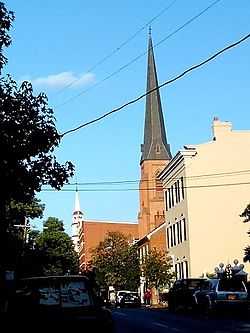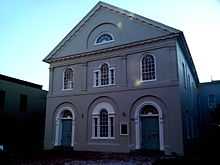All Saints Church (Frederick, Maryland)
| All Saints Episcopal Church Frederick | |
|---|---|
 | |
| Location | Frederick, Maryland, United States |
| Denomination | Episcopal |
| Churchmanship | Broad church |
| History | |
| Founded | 1742 |
| Founder(s) | Maryland General Assembly |
| Dedication | All Saints |
| Associated people |
Thomas Bacon William N. Pendleton John Johns Henry Van Dyke Johns Francis Scott Key |
| Architecture | |
| Status | Parish church |
| Functional status | Active |
| Architect(s) | Richard Upjohn |
| Architectural type | Church |
| Style | Gothic Revival |
| Groundbreaking | 1855 |
| Completed | 1860 |
| Construction cost | $28,800 |
| Specifications | |
| Capacity | 300 |
| Administration | |
| Parish | All Saints Parish |
| Diocese | Maryland |
| Province | Third |
All Saints Church, or All Saints Episcopal Church, founded in 1742, is a historic Episcopal church now located at 106 West Church Street in the Historic District of Frederick, Maryland.[1][2] It is the seat of All Saints Parish, Diocese of Maryland, which covers most of Frederick County, Maryland and once covered most of Western Maryland.
History
In 1742, Maryland's General Assembly separated the westernmost parts of the vast Piscataway (Broad Creek Church) parish to form the large “All Saints Parish”.[3] In 1747, Maryland's Assembly provided for buying land and constructing the parish church on Carroll's Creek, as well as chapels of ease between the Monocacy and Seneca Creeks (which ultimately became Poolesville) and another between the Antietam and Cannogocheague Creeks (which became Hagerstown). In 1770, legislation provided for separating Eden (or Zion or St. Peter's) parishes as well as St. John's Parish, Hagerstown, but such never became effective before the American Revolution.[4] In 1786, Maryland's General Assembly separated the westernmost parts of the congregation to create a new “Frederick Parish” named for Frederick Calvert, the last colonial governor of Maryland, and elevated the former chapel at Hagerstown, Maryland to the parish church.
The original All Saints building, built in 1750, was about four blocks away from the buildings constructed in the next century. In 1759, Rev. Thomas Bacon, former rector of St. Peter's Church in Talbot County, was appointed third "reader" of the parish, which by then was the colony's richest with an income of ₤400 sterling, but he was expected to first compile the laws of Maryland in Annapolis. This caused local consternation such that Rev. Bacon agreed to hire a priest to help him in the 100 mile by 30 mile parish, and moved to Frederick in 1762 upon receiving Governor Sharpe's assent to his appointment, which proved to be his last (he died in 1768).[5]
Bacon's successor, Bennet Allen, the black sheep of a noted clerical family in England, technically served for seven years, but caused a scandal for his lack of learning as well as insistence upon holding another living (St. James Herring Bay) at the same time, contrary to colonial legislation but supposedly authorized by the Lord Proprietor. The vestry almost immediately locked Allen out of the church. Though he climbed in a window to claim the living, Allen soon fled to Philadelphia, hiring a curate to handle the lucrative parish long before the American Revolutionary War (during which he fled to England and was ultimately convicted of killing Lord Dulany in a duel).[6]

Frederick grew rapidly after the war and in 1793 the first Episcopal bishop of Maryland, Rt.Rev. Thomas John Claggett presided over the first confirmation of an American citizen in the church. The original building survived for sixty years, but became too small for the congregation, so a new church was begun around the corner on Church Street in 1813, with a lottery held to help pay off the indebtedness the following year.[7] Famous congregants included Governor Thomas Johnson and occasionally Francis Scott Key of Washington, D.C. as well as the Terra Rubra plantation outside town.
In time too, the 1814 building also proved too small for the congregation's needs, so in 1855, after losing the brothers John Johns and Henry Van Dyke Johns, and several short term rectors including William N. Pendleton, the vestry agreed to hire noted New York architect Richard Upjohn and construct a larger, neo-gothic building, which remains in use today, and whose architecture is discussed below. The 1814 building now serves as the church hall and for administrative offices.[8]

Bishop William Whittingham consecrated it in 1855, and its spire became a local landmark, as is the sculpture of a resting greyhound outside the rectory at 108 W. Church St. During the American Civil War, although many members of the congregation were southern sympathizers (and former rector W. N. Pendleton became a Confederate general), the building served as a Union hospital after the nearby battles of Antietem, South Mountain, Gettysburg and Monocacy. Early in the war, military authorities commandeered the rectory. The congregation buried 11 members by December 1861, and some parishioners deeply distrusted the Northern rector, who left in 1864.
The congregation regained its stability after the war, served by only seven rectors between 1866 and 2006. Some instituted more High Church practices, including incense, Eucharistic vestments and sung services, including Evensong circa monthly.
Architecture
The brickwork of the current seven-bay by three bay, two storey church is common bond, with brownstone trim and a high exposed fieldstone foundation. The sharp four storey tower at the front is one of the seven ecclesiastical towers for which Frederick was known in the Civil war. The quire windows were made in 1910 and imported from Munich. The east side clearstory windows are by Tiffany, and those on the western side in medieval style.[9]
References
- ↑ Maryland Historical Trust sites FHD-669, FHD-670, FHD-688 available at http://mdihp.net/dsp_county.cfm?search=county&id=11887&viewer=true&updated=N&criteria1=A&criteria2=FR
- ↑ Frederick Historic District Survey, NRIS f-3-039, Section 7 p.8 available at http://msa.maryland.gov/megafile/msa/stagsere/se1/se5/010000/010400/010482/pdf/msa_se5_10482.pdf
- ↑ Percy G. Skirven, The First Parishes of the Province of Maryland (Baltimore: Norman Remingon Company 1923), p. 136
- ↑ Rightmyer p. 152
- ↑ Nelson Waite Rightmyer, Maryland's Established Church (Baltimore: Church Historical Society 1956) pp.94-96.
- ↑ Arthur Pierce Middleton, Tercentenary Essays Commemorating Anglican Maryland, 1692-1792 (Conning Company), pp. 56-57
- ↑ http://www.allsaintsmd.org/history.php
- ↑ http://www.allsaintsmd.org/history.php
- ↑ http://mdihp.net/dsp_county.cfm?search=county&id=11887&viewer=true&updated=N&criteria1=A&criteria2=FR
Coordinates: 39°24′55″N 77°24′46″W / 39.41528°N 77.41278°W